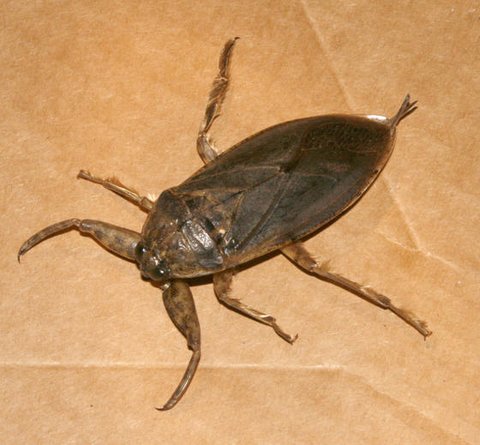Appearance
The giant water bug (Lethocerus americanus) is a large predatory insect that can get up to 2-3 inches in length. A size that allows the insect to boast about being one of the largest insects in north america and in Minnesota!
These insects have a dark brown color to them with banded raptorial legs, or legs that are adapted to catch things. Giant water bugs have commonly been called “alligator ticks” in reference to their tick-like appearance. Additionally, these insects can commonly be mistaken for cockroaches, although they lack the long antennae cockroaches possess.
What does it eat?
Giant water bugs are aquatic predators in slow moving water bodies. These insects will eat anything they can catch with their raptorial legs! Giant water bugs have even been found to eat small frogs, fish, and turtles. Don’t worry though, although they have the common name “toe-biter” any human extremities are not on their menu!
Where and when you find them?
Giant water bugs can be found in any slow moving or stagnant body of water during the summer and spring months. Typically, they are found amongst the vegetation with their raptorial legs in ambush mode: raptorial legs outstretched with the animal’s head pointed downward while it sticks a tube like siphon, called a respiratory siphon, out of the water waiting for prey to swim by. These insects are also found in the summer and spring months around giant electric lights, causing giant water bugs to be found at ballparks, parking lots, and even docks that have bright lights.
Importance to Minnesotans
Giant water bugs keep invertebrate and vertebrate populations down in ponds and lakes. Without giant water bugs, pond systems could potentially be overrun with other aquatic organisms like snails and minnows.
Fun facts
Lethocerus americanus lays their eggs above water on vegetation, where the male guards it from females that would eat the eggs so the male will bear her offspring instead. Some other giant water bug species lay their eggs on the backs of males. The male then carries the eggs around until they hatch.
Giant water bugs also do not have jaws or mouthparts used for chewing. Instead, they have a needle-like rostrum that they pierce through their prey. They then inject digestive juices to liquify their prey and drink it up, almost like a spider!
For more information
Author
Tanner Mierow
Photo credit
alchetron.com


